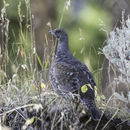pt-BR
nomes no trilho de navegação


Perception Channels: visual ; tactile ; acoustic ; chemical
The Canadian populations of Sage grouse (Centrocerus urophasianus urophasianus) have been listed as endangered by the Committee on the Status of Endangered Wildlife in Canada (COSEWIC). The main cause of this listing has been attributed to loss of native prairie habitat. Presently, the committee on the Recovery of Nationally Endangered Wildlife (RENEW) of Canada is drafting a recovery plan for this species. Appart from this action, there has been little else done to aid the recovery of Sage grouse in Canada.
The status of western subspecies of Sage grouse (Centrocercus urophasianus phaios) within the United States varies. In New Mexico, Arizona, British Columbia, Nebraska, and Okalhoma it is extirpated. Populations have been designated as secure (no federal ranking) in Montana, Wyoming and Idaho. Again, the extirpation of some of these populations can be attributed to loss of native prairie habitat (i.e. sagebrush habitat).
(Aldridge, 2000; Bureau of Land Management, 2000; Alberta Environment, 2000; Braun, 1999)
US Federal List: no special status
CITES: no special status
IUCN Red List of Threatened Species: near threatened
Hunting of the grouse for food and recreation has been historically important to humans.
This species of bird positively benefits humans in that it provides asthetic enjoyment for birdwatchers through observing and photographing their behavior on the lek sites.
The Sage grouse can also act a an indicator of a healthy prairie ecosystem. If the sagebrush communities in North America are in danger, the decline of the Sage grouse can inidicate this.
Sage grouse lack a strong gizzard (an organ birds use to grind up food), as a result their diet is mainly soft foods.
When a Sage grouse is very young (i.e. less than one week old), 60% of its diet is insects. But, as the bird ages, its diet progresses from being mainly insectivorous to herbivorous. By 12 weeks of age, 5% of a young Sage grouse's diet is insects.
An adult Sage grouse therefore, will be predominantly herbivorous, selecting soft plants to consume. Sagebrush leaves (Artemisia spp.) constitute 60-80% of their diet in the summer and nearly 100% of their diet in the winter. Other plants consumed by Sage grouse include June Grass (Koeleria macrantha), Blue Gramma Grass (Bouteloua gracilis), and Western Wheatgrass (Agropyron smithii).
(Patterson, 1952; Johnsgard, 1983; Peterson, 1970)
Sage grouse are found year round as far north as SE Alberta and SW Saskatchewan. Their western limit is northern California and their eastern limit is North and South Dakota. Sage grouse are found as far south as Nevada.
(National Geographic, 1998)
Biogeographic Regions: nearctic (Native )
Sage grouse, as their name suggests, are always associated with some species of sagebrush (Artemisia spp.). These birds rely on sagebrush for leks, nesting sites, feeding sites, rearing sites, protection and wintering grounds. Sage grouse can be found in or near sagebrush habitats year round.
Secondary to sagebrush habitat, Sage grouse also require moist wetland and wet meadows (mesic sites) to aid in brood rearing. Thus, these areas are mostly occupied in late spring and summer.
Another habitat requirement for the Sage grouse are areas suitable for lek sites. Lek sites need to be flat areas that are relatively visible to females. They can range in size from about 0.5 ha to 4 ha and can be located on knolls and ridges. These sites are found to contain little vegetation but are always surrounded by sagebrush communties.
(Beck 1977; Eng and Schladweiler, 1972; Dalke et al., 1963; Clark and Dube, 1984; Drut et al., 1994)
Terrestrial Biomes: savanna or grassland
Average lifespan
Status: captivity: 7 years.
Sage grouse are the largest of North American grouse and are sexually dimorphic.
Males have a grey crown, markings on the back of the neck and yellow lores. The upper chest is brown and buff and the middle is composed of a large white ruff concealing esophageal sacs that inflate during courtship. There is also a large black patch on the abdomen. The tail feathers of males are long and tapered with barring.
Females have more cryptic plumage enabling them to blend into the environment during nesting. They show less white coloring than the males and are mottled with gray and brown to a higher degree. They also lack the espophageal sacs that the males have. The throat of a female is predominantly gray and white. The tail of the female Sage grouse is not nearly as long as the male's.
(Alberta Environment, 2000; Aldridge, 1998)
Range mass: 1 to 3 kg.
Average mass: 2.4 kg.
Other Physical Features: endothermic ; bilateral symmetry
The Sage grouse is a species that employs leks to select mates prior to reproduction (this aspect will be discussed in the next section). After the female has mated with a male on the lek, she will leave and construct a nest 2-6 metres from the lek.
Once the nest in constructed, the hen will lay 1 egg about every 1.3 days for 9 days. This usually results in the female laying 7 or 8 eggs. Laying and incubation of the eggs usually takes about 37 days.
After hatching, the females will remain with the hatched young. In about a week, a hatchling is able to fly short distances. At this time brood will move to a more mesic (wet) site where food will be more abundant. The young remain with their mother until the fall, at which time they segregate sexually into winter flocks.
The following spring, the yearlings will find a lek site and begin the process of displaying and attracting a mate.
(Aldridge, 1998; Patterson, 1952; Beck, 1977; Eng and Schladweiler, 1972)
Key Reproductive Features: iteroparous ; gonochoric/gonochoristic/dioecious (sexes separate); sexual ; oviparous
Average time to hatching: 26 days.
Average eggs per season: 7.